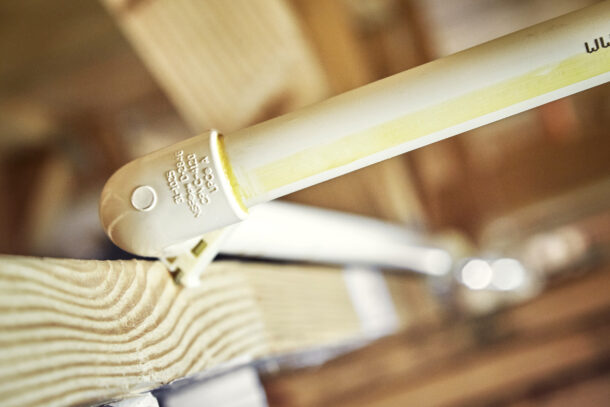Jonathan Simon, Lubrizol Advanced Materials Inc.
CPVC is one of the most widely used plumbing materials in the U.S. and has a number of advantages that make it ideal for residential plumbing. To follow are some tips for working with CPVC to ensure a fast, professional installation that stands the test of time. These tips are specific to Copper Tube Size CPVC (which is typically tan in color) and may not apply to IPS Schedule 80 CPVC (which is typically gray in color). As with any plumbing system, always consult the manufacturer’s instructions for specific handling and installation information.
Cutting and Welding Copper Tube Size CPVC
When installing CPVC, the pipe should be cut square, and any tailings and bevel on the pipe end removed by chamfering. Ratchet-style cutters can be used for new CPVC. For older CPVC pipe, a C-style tubing cutter, fine-tooth saw or wheel cutter is suggested as CPVC pipes become more rigid with age.
CPVC pipes and fittings are solvent welded together to create a bond that is the strongest part of the system. Copper Tube Size CPVC can use one-step solvent cement, such as FlowGuard® Gold 1-Step Yellow or new High Contrast Green Cement. The use of green solvent cement with CPVC was added to the 2024 codes of major bodies, including the Uniform Mechanical Code, Uniform Plumbing Code, International Plumbing Code, and International Mechanical Code.
Because service plumbers often need to make repairs quickly and get to the next job, a specially formulated solvent cement, Oatey® Orange Lava, was developed. It enables one-step cure times as fast as 15 minutes for cold water lines in certain conditions.
CPVC pipes and fittings use an interference fit to ensure a strong bond and it’s a good practice to test the fit before applying solvent cement. When you insert the pipe into the fitting, you should feel some resistance before bottoming out the pipe, which indicates a proper fit.
When applying cement, a good practice is to apply a heavy, even coat to the outside of the pipe end. Then, using the same applicator without additional cement, apply a thin coat inside the fitting socket. After the cement has been applied, the pipe should be inserted until it bottoms out against the fitting.
Always verify code requirements and follow the solvent cement manufacturer’s instructions for cure times and installation procedures.

Avoiding Dry Fits
The friction between the pipe and fitting in a tight interference fit can hold for a long time at pressures above 100 psi without being solvent welded. That means if a joint in the system isn’t solvent welded, the system can still pass a pressure test. Over time, natural movement and stress on the system will cause an unwelded joint to fail. These dry-fit installation errors are extremely rare but can be very frustrating because the failure may occur after the building is occupied.
To avoid dry fits, never pre-assemble the system and then come back through with solvent cement. The best practice is to weld each joint as it is assembled. This also results in a faster installation. For added peace of mind, some contractors may require plumbers to initial joints with a after they are welded. Systems should still be visually inspected and High Contrast Green Solvent Cement makes this quality assurance process easier than ever.
Protecting CPVC pipes
Because CPVC resists degradation from chlorine, chloramines and chlorine dioxide in drinking water, using CPVC eliminates a key factor – incompatibility with local water conditions – that can shorten the life of other plumbing systems. Here are three things you can do to ensure a long life for CPVC pipes and fittings:
- Accommodate expansion and contraction: FlowGuard Gold CPVC can expand about 1 inch per 50 feet of straight length of pipe per 50°F temperature increase. In many cases, normal changes of direction can be enough to account for expansion and contraction provided the natural movement of the pipe is not restricted and there is adequate spacing between elbows and hangers. Overtightening pipe hangers may also restrict lateral movement of the pipe. For long, straight runs, loops or offsets can be used. Consult the manufacturer’s installation guidelines for instructions.
- Check for chemical incompatibility: If properly installed CPVC pipe experiences a failure, one possible culprit is contact with incompatible chemicals. The FBC™ System Compatible Program can be used to identify materials that are compatible and incompatible with FlowGuard Gold, BlazeMaster and Corzan CPVC. For other brands of CPVC piping, consult with the specific manufacturer(s) for compatibility information.
- Protect against freezing: There is no such thing as a freeze-proof pipe. All residential plumbing materials will fail if ice forms in the pipe, blocking water flow and creating pressures that exceed the material’s burst pressure. Always plan for cold weather – even in areas where it is uncommon – and follow best practices for protecting against freezing including those recommended by the pipe manufacturer.
Showcase Your Craftmanship
Professional plumbers appreciate CPVC because it is easy to work with and results in a clean, professional installation that highlights the plumber’s craftmanship and commitment to quality. Builders and homeowners appreciate CPVC because it can handle aggressive water conditions that can cause premature failure in other residential plumbing systems. For more information, visit flowguardgold.com.
These tips are for informational purposes only and do not replace any manufacturer’s instructions for handling or installing pipe.
Jonathan Simon is the North American residential plumbing manager for Lubrizol Advanced Materials Inc., the parent company for FlowGuard Gold Pipe and Fittings.




Join the conversation: